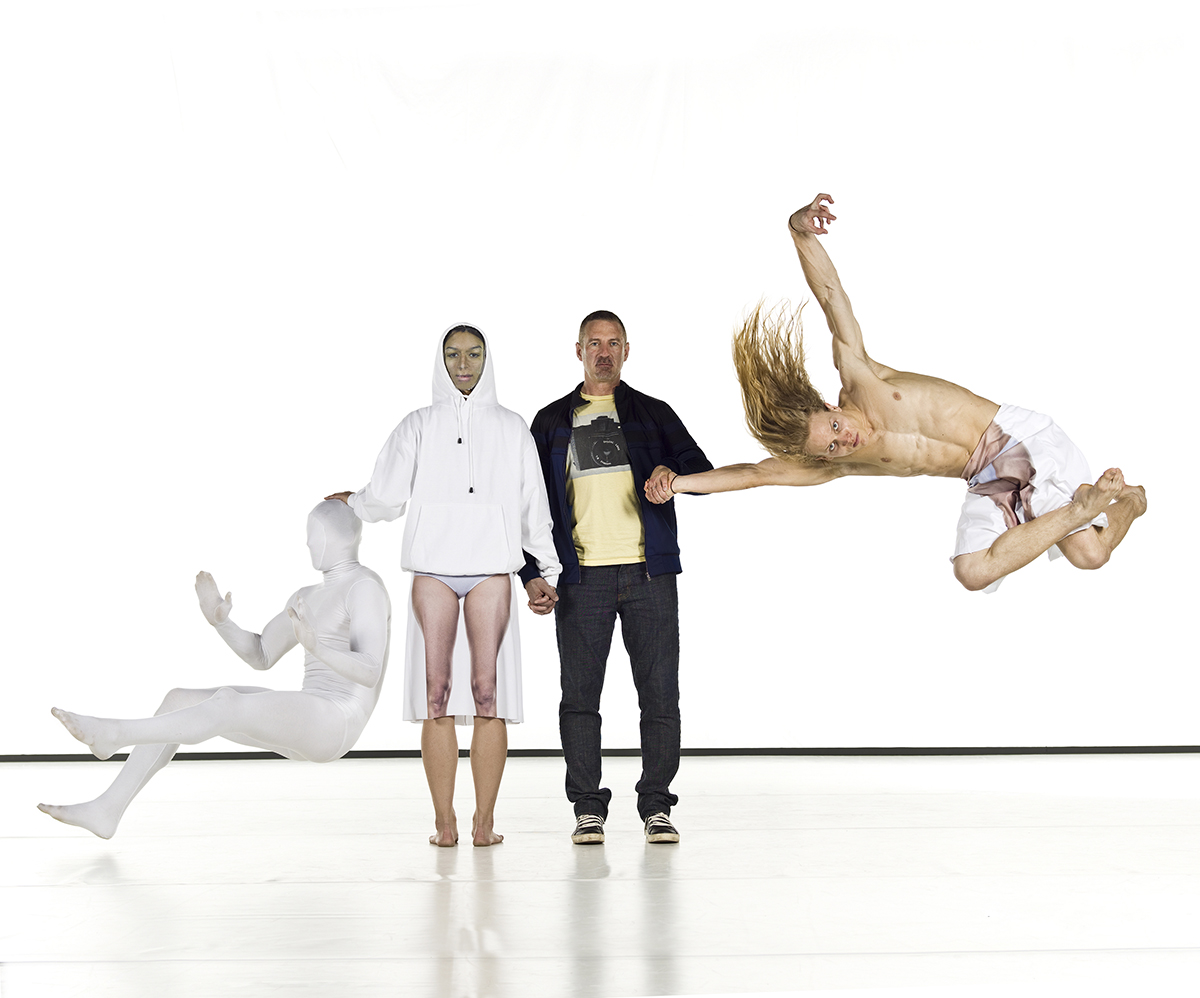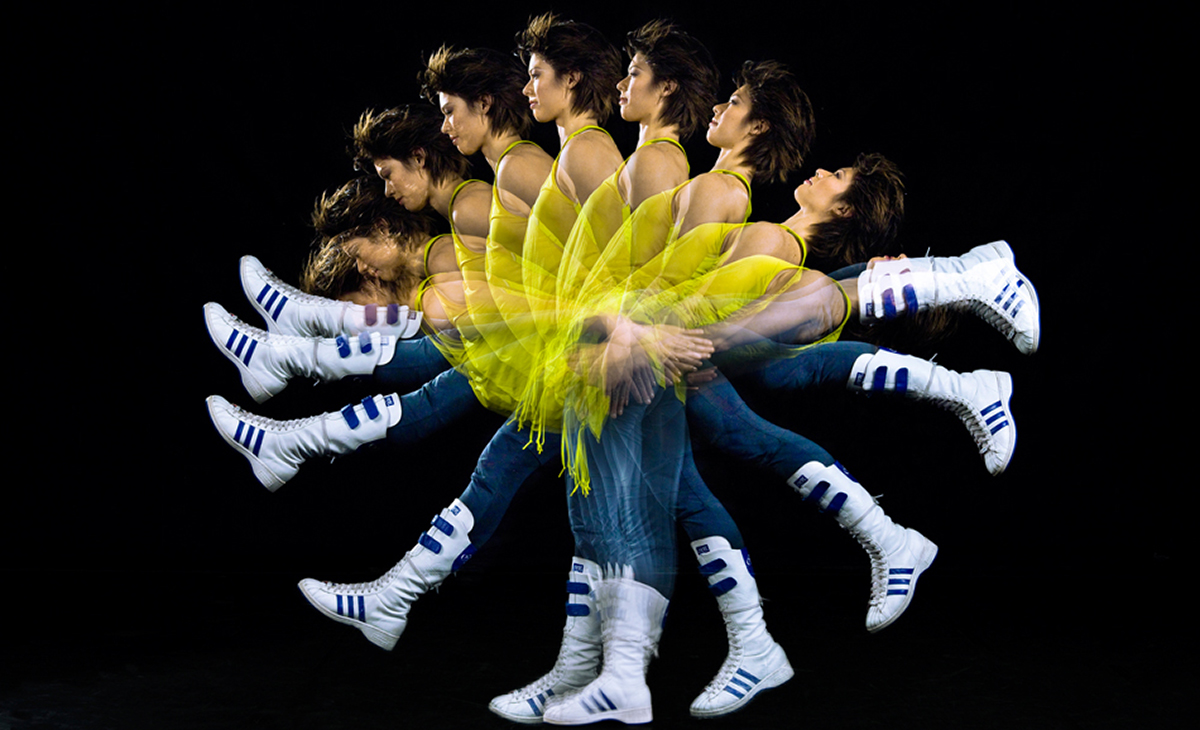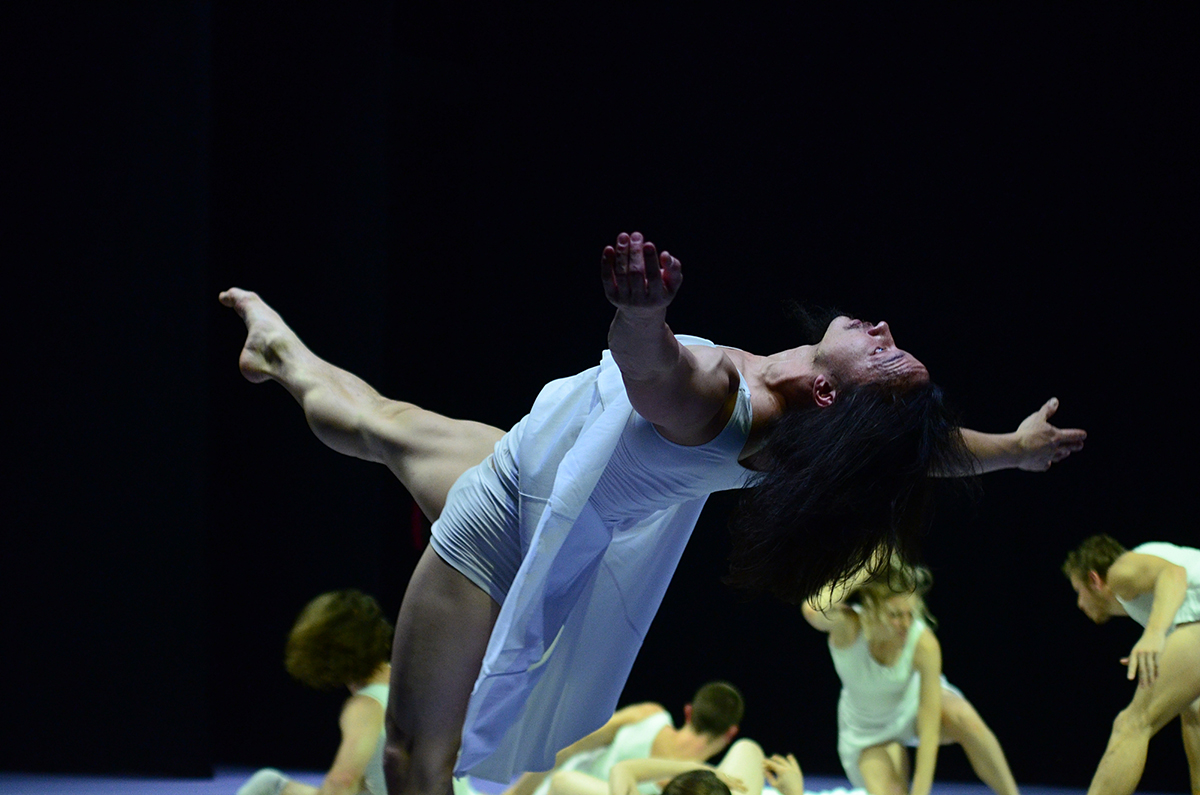
Ever-evolving self: Garry Stewart, artist as researcher
Australian Dance Theatre (ADT) Artistic Director Garry Stewart tells me in an email exchange, “My current Research MFA at UNSW Art & Design actually comes out of Be Your Self,” a work that premiered in the 2010 Adelaide Festival. Stewart wrote a fascinating account of this work’s gestation in 2009 for RealTime. In consultation with scientists and theorists, Stewart drew on the tensions between the rational language of physiological and neurological accounts of the body and the phenomenological experience of the body that we control but which at the same time exerts itself autonomously over us. Be Your Self is a remarkable evocation and probing of this wondrous, sometimes alarming dynamic which is given its full visceral weight in the production — hearts attack bodies, bones grind, tendons crack and inner liquids burble via a score tightly synchronised with movement and triggering the lighting.
Be Your Self, a co-production with Grand Theatre de la Ville de Luxembourg, La Rose des Vents Villeneuve d’Ascq, Le Rive Gauche Centre Culturel de Saint-Etienne-du-Rouvray, Centro Cultural Vila Flor and Arts SA’s Major Commission Fund, has played in 16 cities across Europe and the UK, appeared in Sydney in 2012 (see the RealTime TV interview with Stewart at that time) and is about to open in Melbourne and then tour as Be Your Self (Redux) to seven suburban and regional centres, from Frankston to Townsville. Stewart’s consistent success in achieving international partnerships and extensive touring for his major works for ADT — and which he keeps in repertoire — makes him unique among Australian contemporary artistic directors and choreographers.
Stewart is a tireless researcher and innovator. His collaborators across a number of productions include a roboticist, a video engineer, architects, a physiologist and a neuroscientist. He’s made short films and installations and investigated the relationship between dance and live drawing. He was Thinker-in-Residence at Deakin University in 2012-2013. He writes, that after developing a number of video installation works, “I really wanted to take the opportunity with the MFA research to investigate the form more fully and be challenged in the process of doing so.”

Proximity (2012), ADT, photo Chris Herzfeld Camlight Productions
Neurological mapping
We’ll shortly come to how Be Your Self triggered Stewart’s MFA research. First in our exchange, he mentions how his subsequent work, Proximity (2012), “sits in similar conceptual territory. We used live video cameras and live video effects to suggest that the neurological mapping systems we use to negotiate the world are actual connections between humans and the world.” Stewart’s approach to neurological mapping is infused with French philosopher Maurice Merleau-Ponty’s phenomenology of perception, as is clear in the choreographer’s account of our everyday map-making:
“Your brain creates innumerable maps of your body, both its surface and interior. These operate in concert to comprise our body schema — the sense of our body’s mass, density, position, direction, weight, velocity etc. They are elastic and also incorporate your clothes as you put them on, the pen you are writing with, along with the surface of the paper you are writing on and your car as you drive. This is how you instinctively get to know where your car is in relation to the surface of the road and also to other cars and objects as you drive. Our body schema maps the car into its sense of physical self. We sense if the rear of the car is going to hit something. We instinctively judge how much force we need to put on the brakes when we see another car or pedestrian in front of us. Our body extends its map to encompass the car as a component of itself. It’s the same in sex or holding someone’s hand or even simply looking at someone. We integrate objects within our field of vision into our sense of bodily self.”

Mood Machine (2015)
Emotional expression as choreography
Now, with his “continuing interest in the areas of phenomenology, neuroscience and the shifting nature of choreography,” Stewart is focusing on the body and emotions. He had written in 2009, “Owing to the deeply fundamental way in which we have internalised Cartesian duality and also the prevailing rationalism inherent in Western philosophy and scientific thinking, human emotions have been relegated to secondary status. Conventionally, emotions and feelings are the antithesis of logos and are associated with the feminine and hence are subordinate to the objective logic of rational, male line of thinking.”
Be Your Self’s influence on his research, Stewart tells me, came in the form of “the two-minute video sequence shown in the middle of the work which is a short essay on our expressions of emotion as patterned choreographed sequences.” I had also noted in my review of Be Your Self in 2012: “unusually for contemporary dance, changes of mood are facially, if fleetingly, expressed.” A 2015 commission for Stewart from the Adelaide Film Festival resulted in Mood Machine, a 12-minute film in which a vast range of human expressiveness is compellingly compacted. Clearly, Stewart’s interest in emotion was taking him over a long period deeper into research and the making of new works around the subject.
In a logical extension of the map-making behaviour explored in Proximity, Stewart explains that “we recognise emotions in others through witnessing repeatable and entrained physiological responses that we associate with specific emotion states. Emotions aren’t just nebulous feeling tonalities, but are intrinsically associated with a whole compendium of physiological outcomes that are attached to each motion state. What would happiness be without smiling which causes the upturn of the corners of our mouths, the lift in our eyes and its sense of lightness. Extreme anger produces tension throughout the body and extreme fear results in the dilation of the pupils and shaking.
“The neurological and physiological patterns that underpin emotion expression are choreographies. They are relevant to a discourse of choreography when viewed as a methodology for underlying patterns to emerge. Some time ago I read an essay by Michael Klein and Steven Valk, who had worked as researchers for William Forsythe on the broader phenomenon of pattern generation in nature as an analogy for the choreographic. So I was curious how the repeated neuro-physiological processes of emotion generation embody a dynamic, broader definition of choreography.” Stewart’s thesis and an accompanying installation, he writes, “will focus on this corporealisation of emotions as the raw material for the choreographic.”
As well, his research opens up another possibility. “Against the robust macro choreography of my stage works, I was interested in taking an opportunity to think about the micro-scale of human movement as dance. To some extent this recalls Steve Paxton’s notion of the ‘small dance’ which underlies the act of standing still, but also Erin Manning’s more recent conjecturing on incipient movement and what she refers to as ‘pre-acceleration’ — the welling up of movement before it fully arises through action.”
Just as Stewart’s thinking opens up new philosophical and aesthetic vistas, and the artist continues on as researcher and innovator, so does his organic attitude to his works as perpetually evolving. “I watched a run of Be Your Self yesterday and I haven’t seen it in some time. For me the work seemed completely relevant and germane. It still feels in some ways quite new. This is also because we have new company members since 2010 as well as the fact that it’s difficult for me to leave my work alone. My works are never fully ‘complete.’ To continue to have vibration or aliveness they need to be in an ongoing process of evolution.”

Be Your Self (Redux), image courtesy ADT
Be Your Self (Redux)
This flexibility applies to touring a large work like Be Your Self to small stages. “We just took out the set, making Be Your Self very mobile and more affordable for smaller venues that want to experience the company and this work but where a two-day bump-in with a complicated set makes that challenging. The main use of the set is quarantined to the final scene, which we’ve eliminated. That scene acts as a kind of coda to the work but we found that the work can exist and be powerful without it. It now finishes with a final speech about the phenomenon of having a body as a site of meaning and experience. It’s a beautiful, poetic summation and is delivered alongside an extraordinarily expressive solo performed by the stellar Kimball Wong.”
This apparently upbeat new ending for touring to smaller venues suggests a different vision from the original in which humans come apart, form new shapes or decompose in “an enveloping black void,” as Stewart put it in our 2012 interview, suggesting “a loss of meaning” or “confusion around notions of the body” — but “nothing definitive.” In my review at that time I read the work’s coda as a dark reverie on mortality or even regressive human evolution — doubtless a tad literal of me and less than ‘philosophical.’ For this email exchange I had first asked Stewart if the ideas that informed the work had changed since it’s 2010 premiere; he said no. By juxtaposing my experience of the original version of Be Your Self with the ‘redux’ version when it plays in Parramatta, I might discover the nature of the evolution of my own thinking and emotional response since then.
…..
Read about the UNSW Master of Fine Arts degree here. The two-year full-time or four-year part-time course includes “supervised research and investigation into an approved area of Fine Arts or Media Arts including experimental arts, emerging technologies, creative robotics, digital imaging, interactive and immersive media, creative robotics, sound, drawing, performance” and much else.
–
Australian Dance Theatre, Be Your Self, Southbank Theatre, Melbourne, 2-5 Aug; Be Your Self (Redux), Townsville Civic Theatre, 15 Aug; Northern Rivers Performing Arts (NORPA), Lismore, 18-19 Aug; Empire Theatre, Toowoomba, 24 Aug; The Art House, Wyong, 30 Aug; Riverside Theatres, Parramatta, 2 Sept; Frankston Arts Centre, 8 Sept; Mildura Arts Centre, 12 Sept
Top image credit: Garry Stewart & ADT Dancers, promotional image for Be Your Self by Chris Herzfeld Camlight Productions






